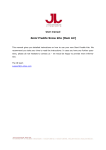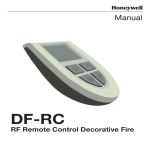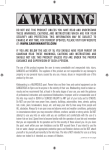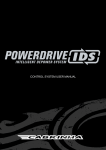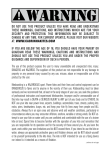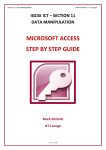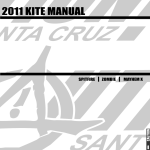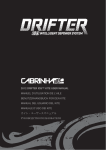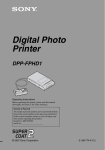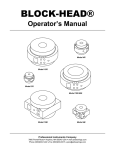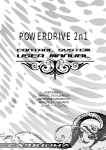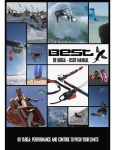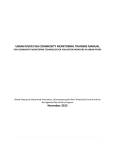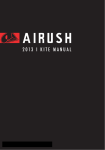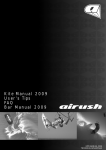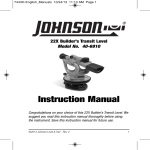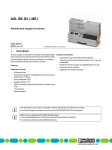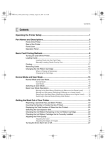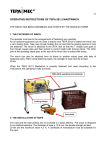Download Kite manual - 2004
Transcript
airush Technical Advantage User’s Manual Dear Pilot, We would like to express our gratitude to you for purchasing an Airush kite. We are sure you will have hours of action packed fun each time you fly. Remember safety comes first and please read the following instruction guide before taking off. Have fun! Airush Development Crew Release of Liability, Claim Waiver and Assumption of Risk Agreement By inflating the leading edge and assembling this product, you are agreeing to; 1) be bound to the terms set forth below; and 2) require anyone using this product to be bound by such terms. If you are unwilling to be bound by these terms return this product (before use) for a full refund. ASSUMPTION OF RISK / IMPORTANT WARNING! Use of this product and any of its components involves certain inherent risks, dangers and hazards, which can result in serious personal injury or death. In using this product you freely agree to assume and accept any and all known and unknown risks of injury while using the equipment. The risks inherent in the sport can be greatly reduced by abiding by the Warning and Safety guidelines listed in this User’s Manual and by using common sense. Kite boarding is not a sport for people under the age of 18 years. If you are learning for the first time, we strongly recommend lessons from a professional instructor connected to an authorized sailing center. Release of Liability and Claim Waiver In consideration of the purchase of this product you hereby agree to the fullest extent permitted by law as follows: To waive any and all claims that you have or may in the future have against AIRUSH, its parent or associated companies, resulting from use of this product and any of its components. To release AIRUSH from any and all responsibility and liability for any loss, damage, expense, accidents and/or injury to people, objects and/or product which may occur as a result of the use of the product, due to any cause whatsoever, including negligence or breach of contract on the part of AIRUSH in the design or manufacture of this product. Possible faults or delays in repairs give the purchaser no right of compensation for damages or warranty extension. Arbitration The purchaser agrees that the laws of Thailand shall govern any disputes, controversy or claims involving AIRUSH. Such disputes, controversy or claims shall be referred to and finally settled by arbitration in accordance with the Rules of Arbitration of the Thailand International Arbitration Center. The language to be used in arbitrate proceedings shall be English. Arbitration shall be commenced within one (1) year from the date on which any alleged claim first arose. Transport costs are at purchaser’s cost as well as costs resulting from the inspection he/she has applied and accepted by AIRUSH. AIRUSH expressly disclaims any implied warranties of merchantability of fitness for a particular purpose and disclaims any and all responsibility and liability for consequential and incidental damage or any other losses arising from the use of these parts, products and/or components. 2 Entire Agreement In entering into this Agreement, you are not relying upon any oral or written representations other than what is set forth in this Agreement and User’s Manual. 3 Safety information and Guide lines: Kiteboarding is an adult sport and should be taken very seriously. Power kites, their lines and control system can be dangerous to flyers and to anyone within the vicinity of their use. Do not use your kite near or around power lines, airports, streets, trees, and keep clear of other people and obstacles. Never allow anyone who is not familiar with traction kiting to use this product without experienced assistance. Safety information and guide lines 5 Contents 6 What to wear 6 Beginning setup 6 Air-Ride control bar 8-9 De-Power loop connection/Safety reset 10-11 Spinning leash attachment 12-13 Kite setup 14 Securing your kite on the beach 15 Lines to kite connection 16-17 Power Zones 18 Steering and control 18 Power and de-powering 19 Choosing a safe location 20 Always learn to use a small-sized, power kite (1-2 meter) before attempting to use this product for the first time. Always use your kite with safety release system. Do not attempt to use your kite in deep water until you are confident and comfortable with its use. Make sure you spend time to become familiar with the operation of your kite and remember that you are responsible for its safe operation and for the safety of those around you. As you learn the sport make sure to work within your limitations and do not exceed them. If you intend to use the kite on the water make sure to always wear appropriate safety and flotation devices. Do not for any reason permanently attach yourself to the kite or its safety system. The kite is not intended for use as a flying device nor is it intended as means for a floatation device. A good rule of thumb when kitesurfing is, to never ride any further from shore than you want to swim in. And always try and ride with a buddy. Launching 21 Self-launching 22 Landing 23 Re-launching from the water 25 Bladder repair 26-27 Kite sail repair 28 Main strut repair 28 Care and maintenance 29 Term 30 Warranty policy 31 NOTE: Airush kites are designed for high performance. If you feel you have been sold the wrong kite, you maybe able to return the unused kite to your retailer and receive a refund. Further safety instructions will follow in this user manual. 4 5 Leading Edge, Main Strut Contents: • Kite bag • Airush kite • Air-Ride fly bar • Pump • Bladder patch repair kit • Optional spinning leash (flow,lift,lift Pro) Red End Trailing Edge What to wear: Struts • Life jacket • Helmet • Eye protection • Wetsuit • Foot protection-booties • Sunscreen Flying Line Black to the Back Red to the Front Beginning Setup: Black End • When setting up your kite and system for the first time we recommend you find some place out of the wind and preferably a nice grassy area so that you can become familiar with the kites system and make sure that it is setup correctly. Knotless Adjustment • Choose an area that has enough room to fully layout your kite and system without any obstructions. • If there is any wind at all make sure to position yourself with your back into the wind. Red End All Connection Points Are Loop to Loop Silver Safety Leader Black End Safety Wrist Leash Red Leaders Pre-Leaders Optional Spinning leash Sheeting System Safety Release Pin De-Power Line Harness De-Power Loop Silver Leader 20 cm- 25 cm Harness Line Quick release safety pull tab Knotless Stopper Balls 6 7 Air-Ride control bar: • With your lines laid out and separated, connect all the kite ends to a solid object, such as a tree, car bumper or pole, using a piece of strong line. (Picture 6) • Start by pulling your bar setup from the bag and set everything else aside for later. • Take notice of the different parts of the bar and safety setup. The safety leash is on one side attached at the end where it feeds through the bar. This line is where the bar will slide along to create the de-powering of the kite once the bar is released. • Your bar has been pre-setup at the factory to try and help decrease the setup time and allow you more time to fly, but you should always check everything and make yourself familiar with the system. • The Air-Ride bar is a patented re-ride kite safety system. When the safety leash is attached to either your wrist or to the spinning leash system and the bar is released. The bar simply slides up the line and lays the kite out flat causing it to de-power until you are ready to re-launch. • The safety leash that is used to secure you to your kite is also supplied with a safety release pin if you ever need for some reason to be completely disconnected from your rig. By simply pulling the ball and releasing the Velcro strap, the safety leash will disengage from you. This is only to be used in absolute emergencies and must be used in conjunction with the other safety features to ensure success; the result can be loss of your kite. (Picture 1) B A Picture 1 Picture 5 Picture 2 Picture 6 • The harness line and the De-Power loop systems are also supplied with a safety release pin if you need to be disconnected from your bar. By simply pulling the red Quick Release Loop you will free yourself from the harness line or from the De-Power loop, the kite will depowered completely as the safety leash takes hold. We recommend you practice activating the safety system before you fly the kite. (Picture 2, 3, 4) • To re-set the Quick release safety system thread the two loop ends together and insert the release pin. (See instruction page 10 - 11) • The goal for all the adjustments is to end up with all lines even at the ends with the de-power loop and sheeting system positioned all the way out (powered up position). (Picture 7) • The first few times you fly on your bar system, the lines and knots will settle in and slightly change. So always make a point to check your lines after the first few sessions of flying or if your kite feels to pull to one side. Picture 3 Picture 7 • After all has been setup correctly and if you prefer to have your safety leash on the opposite side simply remove your harness line, flip the bar over and re-attach your harness line correctly. • Now that you have your bar setup and ready, take your time and wrap your lines back onto the bar. You will learn that taking your time wrapping your lines will result in less line wraps when you lay them out the next time. (Picture 8) • Layout your lines and separate them parallel to each other starting at the bar. (Picture 5) Notice that the line ends are colored, Black and Red. The rule to remember is “Black is back”. Meaning that the Black ends should always be connected to the back, or trailing edge connection points on their corresponding sides of the kite. Red is for the front, or leading edge connections, to their corresponding sides. 8 • With the ends attached to a solid safe object and your depower loop all the way against the bar and sheeting system all the way out (powered up position)(Picture 7) grab your bar and pull back with a good amount of pressure. As you apply and release pressure, all lines should rise and lower evenly and the bar should be perpendicular to the center lines. If this is not correct you will need to do small adjustments to all lines to compensate for this difference. It is important to weight each line individually and then do adjustments. As you pull, each line will begin to lock the fibers into place and minimize a stretch feel in the line. The more time you spend locking down the lines the less work and adjustments you will do later. Tip would be to wrap lines into the bar in a figure 8 pattern. Picture 4 Picture 8 9 De-Power loop connection / Safety reset After you have used the quick release safety system, use the following instructions to ensure that it is reset correctly. Take your time to familiarize yourself with the entire system, from activating it to resetting it. • Locate the loop at the bottom of the de-power line and the loop on the top of the de-power loop system. Notice that the black webbing above the loop on the depower line has a channel in the webbing. This is to secure the retaining pin. (Picture 9) • Identify the webbing closure straps, wrap them around the system and secure with the attached Velcro. This will insure you do not trip the system accidentally. (Picture 12, 13) Picture 9 Picture 12 Picture 10 Picture 13 • Insert the de-power line loop into the loop on the chicken loop. (Picture 10) • Cover the safety pin with the neoprene sleeve. (Picture 14) • Thread the retaining pin through the loop and into the webbing channel. (Picture 11) Picture 11 10 Picture 14 11 Spinning leash attachment *** Warning: The spinning leash is recommended for expert users only. Connecting yourself to the kite using the spinning leash system is dangerous. Please ensure that you familiarize yourself with all the aspects of this system and practice tripping the safety system before you launch your kite. If you are not confident in using this system please contact your local Airush dealer for instruction and use the standard De-Power loop and safety wrist leash instead. • Locate the spinning De-Power loop with the plastic retaining tube attached. (Picture 15) • Follow instructions “De-Power loop connection/Safety reset” to connect the spinning De-Power loop. (Page 10-11) Picture 15 Picture 18 • Before launching your kite hook the chicken loop with the black plastic retaining tube onto your harness hook. (Picture 19) • Disconnect the leash from the wrist cuff (Picture 1A), and connect it to the figure 8 ring on the spinning DePower loop. (Picture 16) Picture 16 Picture 19 • Make sure you insert the black plastic retaining tube through the harness hook. (Picture 20) • Thread the pin through the ring and retain using the webbing and Velcro strap. (Picture 17-18) • The plastic retaining tube attached to the spinning leash de-power loop must be inserted through the harness hook to ensure that the re-ride kite safety system will operate correctly. Picture 17 12 Picture 20 To activate the re-ride kite safety system when using the spinning leash system you must pull the red quick release loop attached to the depower loop and release the kite bar. (Picture 3-4) 13 Kite Setup: Securing your kite on the beach: • Layout your kite with struts facing up. If you are in any wind at all put some sand or weight on one wing tip and let the kite lay out down wind away from the weight. (Picture 21) • Inflation of the struts is done by using the pump supplied with your kite. (Picture 22) • Inflate the struts from one side to the other. When you are doing this for the first time inflate each strut till it begins to take shape applying only a light amount of air pressure. Then squeeze each strut from end to end making sure that the internal bladder fills all the internal space and that there are no voids. Then continue inflating. Picture 21 Picture 24 • At this point you are ready to attach your fly lines. Turn your kite over, struts facing down, and leading edge facing into the wind and secure with sand of weight bag.(Picture 24) • DO NOT OVER INFLATE THE STRUTS. Once it is fairly firm to the touch, it is fully inflated. • Always secure your kite with more weight than you think you need. An unmanned kite can be very dangerous. If you don’t have a sandy beach consider getting an Airush kite weight bag.(Picture 25) • Once you have a strut fully inflated remove the pump and if the pressure is high enough the internal one-way valve should close off* and allow you time to insert the valve. At this time wrap the Velcro over the valve to protect it from inadvertently opening. (Picture 23) * Please note not all struts have the internal one-way valve, it depends on the model of the kite. Struts and leading edge bladders without a one-way valve need to be pinched between your thumb and fore finger before the pump is removed. By inserting the valve head the pressure will remain. • The main leading edge strut is important to pump up correctly with the right amount of pressure. Over inflate and you can damage the strut. Under inflate and the kite will be difficult to re-launch off the water. The best rule of thumb to use for this pressure is to pump until the wingtips rise and hold themselves up. At this point pinch the valve to hold the pressure in, remove the pump and insert the valve cap and wrap the Velcro around the valve cap.(Picture 22-23) Picture 22 Picture 25 • Never secure your kite with sharp objects, such as rocks or a board with sharp fins. • Be aware of other beach users and riders. When you are not launching or ready to ride, keep your lines wrapped on the bar, so that the beach or area is clear of lines that can easily get in the way of someone. • With the struts fully inflated begin pumping up the main leading edge strut. If at this time you have weight on a wing tip remove it so that the tips can rise as you pump the main strut. Picture 23 14 15 Lines to kite connection: • On the side that corresponds with that side of the kite take the Red and Black ends of the fly lines and pull them to that tip, keeping them apart. • Begin by laying out your fly lines down wind from the bar and separating them so that your two Red ended center lines are a good distance apart from each other then lay the two Black ended lines on either side of the red lines that correspond to that side. • Start by attaching the Red, Front line, using a larks-head, slipknot, behind the second knot from the end. (Picture 28) • Carry your inflated ready to attach kite to the ends of the lines and place struts facing down and nose facing the bar, into the wind and secure with weight. (Picture 26) Picture 26 Picture 28 • Then take the Black ended line and attach it using the same knot, just behind the first knot.(Picture 28) • On each wing tip you will notice two connection points, the one that is closest to the ground is the front or leading edge connection point, this is for connecting the RED ended fly lines to. The other one on each tip is the Back or Trailing Edge connecting point, this is for connecting the Black ended fly lines to. (Remember Black is back) (Picture 29) • At each connecting point there are a number of knots to hook to. These allow you to customize how you want to connect your kite and also allow you to compensate for line stretch. Placing your front fly lines further in on the knots than on the back connection point you can decrease the power of your kite to begin with. (Picture 28, 29) • The Trio and Flow kites you have three points to connect the back lines (Picture 27). By attaching your back flying lines to the different points you can tune the turning speed of the kite. Back position for normal speed, middle for medium speed the forward position for slow speed. We recommend beginners start on the slow setting and gradually move the lines back as skill levels increase. Black back • After everything is connected always check that the Black is attached to the back, and that the right is to the right and left is to the left. Its always better to check twice and Act once!! If things are hooked up wrong the kite can respond improperly when launched and can be very dangerous. Red front Fast Medium Slow Picture 27 16 • Once you have finished attaching one side of lines to the kite, repeat for the other wing tip. Making sure to attach to the same positions as you have done on the other wing tip knots. Picture 29 17 Choosing a safe location: Wind Launching: • Choose an area where you have at least 100 meters of space downwind and to each of your sides. • Always observe local rules and regulations before using this product. • Never go out in any offshore wind conditions. • Do not fly your kite over people or pets. • Never use this product on crowded beaches or fields. • Never launch your kite straight down wind. The kite will launch and create way too much power and can endanger you and those around you. Picture 35 • A good rule for direction to launch is to put your back facing the wind, spread your arms out to your sides and slightly bring them forward, the direction your hands are pointing is the direction your lines and kite should be laid out from your location for a correct launch. • Make sure to always launch your kite in lower winds when flying the first time. • Having someone to assist you in launching your kite is always the best way. Not to mention its much more enjoyable to learn the sport with a friend. • Have your assistant hold the kite by the main leading edge bladder facing into the wind. (Picture 35) • The person launching should NEVER throw the kite into the air. Picture 36 • Return to your control bar, Attach your safety leash cuff to that corresponding wrist, or connect the spinning leash to your harness hook.(Picture 36) • Using both hands hold your control bar and put a slight amount of pressure on the lines. At this time check that your lines are attached to the correct sides and that nothing is tangled.(Picture 37) • As you begin to put pressure on your fly lines, you will need to check that your kite sail is not fluttering. If the kite sail is fluttering then you will need to move yourself up-wind till the angle of your kite changes slightly and the sail becomes taunt. Now you are ready to launch. At this position the kite will want to move forward and begin flying once launched. Picture 37 • Give a signal to your assistant that you are ready. It's always better to use hand signals at times it can be hard to hear when the wind is blowing and having a kite launched when you are not ready can be very dangerous. So giving a thumbs-up motion is a good way to signal that your ready to launch.(Picture 38) • Slowly steer the kite along the edge of the wind to the straight above, or neutral position as we call it in kite terms.(Drawing page 18) • Take your time and get used to the control response of the kite. The Airush kites are very responsive compared to other kites and you will need to get used to this difference. 20 Picture 38 21 Power and de-powering: Power Zones • The two lines that come to the center of the bar that attach to the front or leading edge of the kite (Red) are for changing the angle of the kite allowing the pilot to increase or decrease the power of the kite. Neutral Zone/Less power More Power Most Power • De-powering and powering up of the kite can be obtained two ways. Either by pulling in and out on the harness de-power loop that is fed through the bar (Picture 31-32), or by using the sheeting strap system that is tied to the de-power loop set just in front of the bar.(Picture 33-34) Wind Direction Steering and control: De-Powered • The outside two lines of the bar that attach to the back or trailing edge of the kite are referred to as your turn or control lines. When pulled to each side the kite is warped to turn in that direction. Powered Picture 32 Picture 31 • Pulling in on the sheeting strap will cause the kite to tilt slightly forward and decrease the power of the kite (Picture 33). Pulling on the power up loop will increase the length of the strap and will make the kite to power up and cause more pull (Picture 34). The Airush strap also allows you to power up in small increments, unlike any other system. By simply pulling in on the power up loop the amount you want then releasing allows for small adjustments to the system. • Hold the control bar with both hands just in from the ends from each side.(Picture 30) • The kite is controlled by pulling in on each side of the bar, a left pull will make the kite turn left and right pull will make the kite turn right. • Make sure you do not twist the bar. This does not have any control on the kite and can confuse you. Picture 30 • Don’t make any quick moves when learning to fly, the faster the kite moves the more power it can generate. • Remember if you pull one side to turn one way make sure to return that side back out before pulling the other side. Always keep your hands in front of you when flying. • Take your time and only fly your kite in lower winds at first so that you don’t get over powered and lose control. 18 De-Powered Powered Picture 33 Picture 34 • These adjustments should only be done in small amounts. If you over De-power the kite you can decrease your control inputs to the kite by making your back (control) lines to become over slacked. 19 Landing: Self-Launching: • Again like launching with assistance, place your kite to the side of the wind. • To land the kite you will want to slowly fly your kite to the edge of the wind, slowly fly close to the ground and allow someone to catch it at the front edge, NEVER allow someone to grab the kite by the fly lines or trailing edge of the kite when landing. Wind • Weight the lower or bottom wingtip down heavily with sand or Airush kite weight bag. (Picture 39) • Return to your control bar and thoroughly check your lines to make sure everything is connected correctly. Remember if something is wrong, you will have to release your safety and the bar, so again a good rule to remember is “think twice act once”. • Once your helper has a hold of your kite make sure to walk quickly toward them to decrease the pressure on the sail and stop the kite from generating power. Picture 39 • Attach the safety wrist leash to your wrist, or attach the spinning leash system to your harness hook.(Picture 40) • With the control bar in both hands, begin to step back till the lines become taunt. At this time with a swift tug the kite will release the sand or weight and begin to fly. • It is very important to always keep your eye on the kite even after someone has a hold of it. If the kite is released by mistake you will want to quickly be aware and release your safety if necessary. Until you have your hands on the kite consider it a live kite or able to generate power. • When landing alone or bringing the kite down unassisted, it is always better to be over water to keep from damaging your kite. • Once the kite is free of the ground slowly fly the kite up to the neutral position and again check that all controls feel correct. Picture 40 • When self-launching you should always have your lines set out and ready. Never weight your kite then unroll your lines. If something were to go wrong, you have no way of controlling the kite. • If something goes wrong, pull the red safety tab and or release the bar. • Lower the kite to just off the water at the edge of the wind and release the bar utilizing the safety system. This will allow the bar to slide up the line and flatten the kite out. Allow the kite to settle onto the water and then walk to the kite holding onto the safety line only till you have ahold of the kite. • Once you get to the kite carry it to the beach or landing area and place struts down, nose into the wind and apply weight or sand to the leading edge to keep it in place (Picture 41). Then sort out and wind up your fly lines. Picture 41 22 23 Re-launching from the water: • It is very important to have the proper inflation pressure in all struts, mainly the leading edge to make re-launching of the kite easier. So always make sure all struts are inflated properly before getting into the water. • If the kite goes onto the water nose down, leading edge on the water, you will have to swim slightly to one side at the same time working the kite to the other by pulling on that corresponding side of the bar. The best method if the kite is directly down wind of you, is to swim towards the kite holding one side of the bar. As the kite flips back continue to hold one side till the kite works its way to a side. At times it is better to continue swimming till the kite is completely to the side and begins to re-launch itself and begins flying. • When the kite is on its side at the edge, slowly pull the bar from side to side, working the kite till it re-launches off the water. • As your kite begins to re-launch make sure to not over control the kite and stall it backwards. Slowly allow it to drain the water from the sail and begin to fly. The best hint is to be patient and allow the kite to work itself to the edge and relaunch. • Keep in mind all kites will take some practice getting them to re-launch efficiently. • It is always better to practice re-launching in shallow water where you are able to touch the ground, before proceeding to water that is over your head. Remember practicing such things can save you a long swim in. 24 25 Bladder Repair: • For any major cuts or rips make sure to consult your local Airush dealer or kite repair center for assistance. • Most of the time you will usually hear the leak. But you can also submerge the tube in water to locate the hole. • Before attempting any bladder repairs make sure your kite is clean and dry. • Once you have located the leak, dry the area and mark with a permanent marker.(Picture 44) • Avoid repairing your kite on the beach or on dirty, or windy areas. A grassy clean place out of the wind area is preferred. • Select a patch from the self adhesive pack. • Make sure to deflate all bladders when doing repairs. • Remove the paper backing from the patch and apply to the leak - apply pressure to ensure good adhesion. (Picture 45) • You will need one of your fly lines, or an extra piece of line before you start removing a bladder from the kite. • Next lightly sand the area where the leak is. Picture 42 Picture 44 • Again inflate the bladder and check that the leak has been taken care of. • Lay the kite out flat, struts facing up. • Deflate once again and tie the line back onto the valve. • Detach the Velcro closure at the base of the damaged strut. This will open up the strut casing and allow you to access the bladder.(Picture 42) • Slowly pull the bladder back into the casing from the end. Making sure the bladder aligns itself inside the casing. • Next tie on an end of the extra line to the air valve of the strut being removed.(Picture 43) • Once the bladder is replaced gently work the valve and Velcro back into its hole. • Gently push the valve down through its hole in the strut casing. • Go to the end of the strut and slowly pull the bladder out as the line you tied to the valve feeds into the valve hole. Having the line through the strut sleeve will allow you to easily replace the bladder once it is repaired. Picture 43 Picture 45 • Make sure to close the Velcro at the end and then slowly inflate the bladder. • As the strut begins to take shape make sure the bladder fills the inside casing and that there are no voids. • Inflate the bladder using your pump. 26 27 Kite Sail Repair: • Any major tears or repairs to the sail area, we recommend you consult your local Airush Dealer or Airush kite repair loft for assistance. • Minor tears can be taken care of with the supplied sail repair tape. Care and Maintenance: • Make sure to thoroughly clean and dry the surface being repaired. To prolong the life of your kite and equipment you should follow these very important instructions. • Lay the kite out flat on a smooth table or surface. • Never store kite for any extended time in bag if at all wet or moist. Doing so can cause colors to fade and bleed into each other. If sail is wet allow the kite to dry completely out of direct sunlight. • Cut two matching pieces of material, one for each side of the sail that covers the tear at least one inch all the way around. • After use in saltwater it is always good to wash all gear thoroughly using fresh water and allow to dry out of direct sunlight. Never use high-pressure water against the kite sail. • Carefully place one piece onto one side, making sure that the tear lays together along the rip. • Then cover the other side matching the piece placed on the first side. Picture 46 • Many fliers store their kites with the struts inflated rolled up and placed in their bags. This will never cause any serious damage to your kite. But we highly recommend after use, to lower the pressure for storage, to decrease any unwanted stretch in strut material. Main strut repair: • Repairing the main leading edge strut is done exactly the same way, except you will have to feed a line from each direction from the tips (Picture 46). Pulling the bladder through the zippered opening located on the inside of the main strut off to the side of the valve (Picture 47). • The worst culprit that will damage your kite is UV from the sun, over time your sail will begin to break down from exposure, but by making sure to either cover or store your kite out of the sun light while not in use will drastically increase the life of your kite. Picture 47 • It is very important to fold the bladder flat off to one side of the opening when reinserting it so that you do not get any twists while it is fed into the slot (Picture 48). • The second most damaging affect on a kite is leaving it sitting, inflated, main strut down facing into the wind. In this manner the wind can cause the trailing edge to flap loosely like a flag in the wind. If allowed to flap in this manner the trailing edge material will begin to break down and cause unwanted material stretch along the trailing edge, which will drastically decrease kite performance. If you are intending not to use your kite for any period of time we recommend releasing the pressure from the main strut so that the sail is allowed to lay flat on the ground so as to not allow the trailing edge to flutter in the wind. • Periodically throughout the life of your kite, check all connection points and sail for damage and make sure to repair small tears as needed. Small tears can become large tears with one bad crash. Having a connection point break can result in a long unwanted swim to shore. • It is also very helpful to apply a baby powder to the bladder before reinserting. It will allow it to easily align itself when pumping it back up. Picture 48 28 29 Terms: Warranty Policy • Edge of the wind The furthest point in which a kite will fly into the wind. Airush warrantees this product to be free of major manufactoring defects in material or workmanship to the original purchaser for a period of 12 (twelve) months from the date of purchase. This warranty is subject to the following conditions: • Hendenburg When a kite flies beyond the edge of the wind and falls forward out of the sky. • Neutral position Position straight above the flier at the top of the wind window. 1. The warranty is valid ONLY when the warranty card is properly filled out and returned to the dealer where the purchase was made or to the national distributor within 7 days of purchase. • Fly lines Lines that run from the ends of the leaders and are attached to the kites wing tips. 2. The warranty is valid only when product is used for normal recreational activities. • Leaders The lines that run from your bar and are attached to your fly lines. 3. Airush will make the warranty determination, which may require inspection and/or photos of product, which clearly show defect. • Harness loop Rubber loop attached onto your fly bar that is used to hook in and out of your harness hook to transfer pull to your body. 4. If a product is deemed to be defective by Airush, the warranty covers the repair or replacement of the defective product only. Airush will not be responsible for any cost, losses, or damages incurred as a result of loss of use of product. • Gybing The motion in which a pilot changes the direction of the board to head in opposite direction. • Overpoewered When the pilot has a kite too powerful for his or her ability level, weight, strength or wind condition. • Onshore winds Winds that are blowing off the water onto the shore. • Sideshore winds Winds that are blowing parallel to the shore. • Offshore winds Winds that are blowing from the land onto the water. • Downwind Direction in which the wind is traveling away from you relative to your position. 5. The warranty does not cover damage caused by misuse, abuse, neglect of normal wear and tear including, but not limited to, punctures, rigging with other than Airush components, damage due to excessive sun exposure or seam failure due to over inflation in the sun, damage caused by improper handling and storage, damage caused by use in waves or shore break and damage caused by anything other than defects in material and workmanship. 6. The warranty is voided if any unauthorized repair, change or modification has been made to any part of the equipment. 7. The warranty for any repair or replacement equipment is good for the date of the original purchase only. 8. The original purchase receipt must accompany all warranty claims. The name of the retailer and date of purchase must be clear and legible. 9. There are no warranties, which extend beyond the warranty specified here. • Upwind Direction in which the wind is traveling towards you relative to your position. • Gusty wind Wind that is inconsistent and varies greatly in strength. 30 31
















